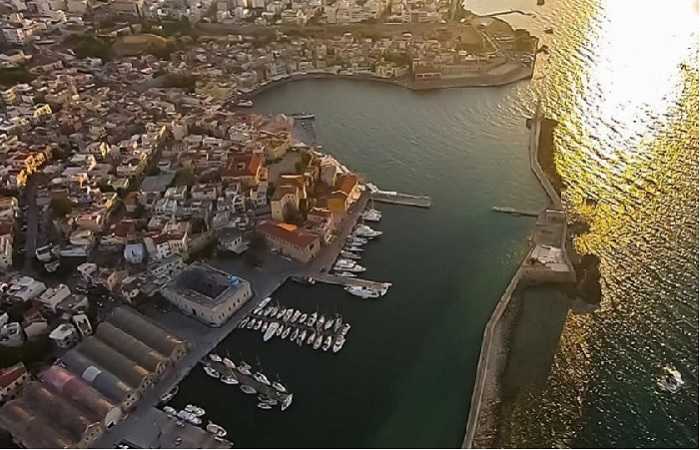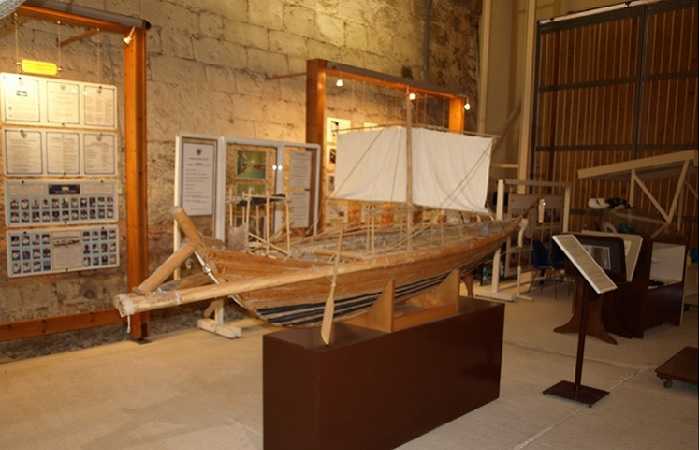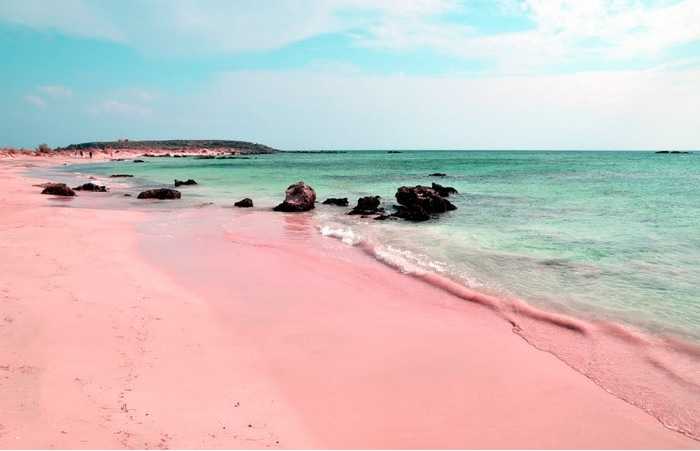Geographical coordinates of Chania:
- latitude: 35 31′00″ north latitude
- Longitude: 2401′00″ East
Chania on the map
It is located along the northern coast of the island, about 70 km (43 miles) west of the city of Rethymno and 145 km (90 miles) west of Heraklion.
The city has a typical Mediterranean climate, with sunny, dry summers and mild, rainy winters. It has a temperate Mediterranean climate, perhaps the mildest and most favorable for recreation on the coast of Greece.
In summer, the average air temperature fluctuates between 25-30 degrees, in winter it is also quite warm - + 13-18 degrees. Rain in Chania is very rare. The warmest Mediterranean Sea off the coast of Chania becomes in July-August, at the peak of the season the temperature of sea water is kept within 25 degrees. You can come to rest in Chania all year round, however, in winter you risk falling under warm winter rains.
Chania attractions
The best sights of Chania are hidden in the Old Town. Seasoned tourists are witnesses that Chania is one of the most picturesque ancient cities in Greece, and besides, for gourmets who know a lot about natural homemade food, this is a real paradise!
The best way to get to know the city of Chania is to wander along its ancient stone streets, look into museums and admire all kinds of architectural styles that generously filled the streets and squares.

The historical route of the city is an exciting experience! The territory of Chania was once ruled by the Arabs and the Byzantines, at the beginning of the XIII century it was conquered by the Venetians (1252), and at the end of the XVII century the Ottoman Turks came here, who controlled the city and the island until 1913. Only in 1913 Crete (and the city of Chania) was annexed to the Greek state.
Old city
The Old Town of Chania is the best historical attraction not only of Chania, but of the entire island of Crete. It is built around the Venetian port, marked by fortified Venetian walls within its borders, filled with Venetian buildings and elements of Turkish architecture, which together created a unique architectural appearance.

The boundaries of the Old City are separated by a Venetian fortress wall separating it from the new city of Chania. Unfortunately, part of it was destroyed and did not reach our times. There is also the bastion of St. Demetrius (another name is Schiavo, geographical coordinates: 35.514828, 24.016583). The old city is declared a historical value of the island of Crete, it is carefully preserved and protected.
In general, old Chania consists of five districts that surround the Venetian port.
The center of the old city (Palea Poli) is the district of Kastelli, which was inhabited in the Neolithic era. Castelli is located on a hill, above the port, in the past, during the Venetian rule, the area performed a defensive function - the palace of the Venetian ruler towered here, and later - the residence of the Pasha of Chania. On the shore of the Venetian port, the Kyuchuk Hassan mosque rises, and the Venetian arsenal of the 15th century is also located here.
Splantia
To the east of the Old Town is the Splanzia or Plaza area, built on the site of the former Turkish quarter. People come to Splantia to admire the church of Agii Anargiri. The Church of the Holy Besrebrennikov (as it is also called) was the only Orthodox church that functioned during the period of the Venetian and Turkish occupation. The church of St. Nicholas and the church of Rocco are also located here. And in the Splantia quarter you can see Sintrivani Square.
Neoria
Neoria (Neoria or Chiones) is an area in the northeastern part of Chania. It is located in the area of the former port of the city, where the Venetian shipyards were located in the XIV-XVI centuries, from where the name came from.
Jewish Quarter
The Jewish Quarter (Ovraika) is located southeast of the old city. It was formed during the reign of the Venetians, when the Jewish population, under pressure from the authorities, was forced to move to one area, which was called Judeca. Two synagogues were built here at one time. On the territory of the Jewish Quarter, on Chalides Street, there is the Folklore Museum of Chania, as well as the Franciscan monastery of Agios Fragkiskos (Aghios Fragkiskos, XIV century), which houses the archaeological museum of Chania.
At the southern end of the Jewish quarter of Ovraika, leather street Odos Skridlof is lined with endless shopping malls selling leather goods, shoes and souvenirs. This is the so-called Stivandika area. Cretan boots - stivania in Greek are called stivani (stivani). Among the shops you can find several Cretan traditional shoe shops, which will show you how local leather shoes are made.
On Leather Street, you can buy a wallet, a bag, summer sandals and real Cretan winter boots as a gift. Here you can also sew custom-made shoes for yourself, or by walking further, you will get to Tsuderu Street (Odos Tsouderou), which will lead to the city market of Chania. The market building (date of construction -1911) was built in the shape of a cross and oriented to the cardinal points.

Another notable street is Karaoli Dimitriou, famous for its knife making workshops. By the way, the original Cretan knife will cost at least 200 euros.
While traveling through the Old Town, explore the preserved old fortifications, see the ancient Venetian port, take a walk to the coastal cliff, which houses the sea lighthouse. The navigation facility was built back in 1570 by the Venetians, in 1830 it was reconstructed and since then it has helped sailors navigate when entering the port.
Museums of Chania
To visit the museums of Chania, you should allocate at least two days. The fact is that the museum collections of the city open up to visitors a huge world of Mediterranean architecture that has developed on the island for more than two thousand years!
Big Arsenal
The Grand Arsenal is an interesting cultural center, which regularly hosts thematic exhibitions and various cultural events. Its modern name is the Center for Mediterranean Architecture.
![]()
The Venetian Arsenals in Chania consisted of 22 buildings, 17 of which were already in operation in the second half of the 16th century, and five more were completed later, east of the port of Neorion tou Moro. In those days, the Venetian ships were a powerful flotilla on the Mediterranean Sea and the arsenals served so that they could repair themselves in the harbor, wait out the danger, if necessary, load up with provisions and weapons.
The arsenals in Chania are large stone domed chamber-fortresses on the water, with frontal walls with arched openings through which one could go from one room to another. Each arsenal is about 50 meters long, 9 meters wide and 10 meters high.
The Grand Arsenal, in which the cultural center functions today, stands a little apart from the rest of the Venetian coastal shipyards, look for it next to the modern promenade of Chania, which blocked the access to the sea for Venetian monuments of history and architecture. Once the last Venetian dock functioned in the building, the construction of which began in 1587.
New life entered the building in the era of the Ottoman rule - in 1872 several government offices were located here. In 1941, the reconstruction began, which was finally completed in 2002 and now there is a full-fledged exhibition complex - the Center for Mediterranean Architecture!
- Opening hours: 8.00-15.00.
- Address: Defkalionos Street, Venetian port of Chania, tel. +30 28210 402 01.
Archaeological Museum of Chania
It is located in a building, which in itself is already a landmark of the city, at the bottom of Khalidon Street. The museum presents archaeological exhibits that were found in the region of Chania and Western Crete.
- Ticket price: adults - 4 euros, preferential - 2 euros.
- Opening hours: Tuesday - Sunday 8.00-15.00, closed on Mondays and public holidays. During the tourist season (from June to October) the museum is open daily from 9.00 to 20.00.
- Address: Chalidon 28, Chania 73100, Greece, tel. +30 282 1090 334.
Maritime Museum of Crete
The second oldest maritime museum in Greece, which contains exhibits from the Bronze Age onwards - the Byzantine period of the history of the island, the Venetian occupation, the time of the Balkan wars, the periods of the First and Second World Wars. Even in the museum's collection you can see a permanent exhibition of ancient and traditional shipbuilding (reconstruction of a Minoan ship, etc.).

The museum is located on the territory of the old harbor (Old Harbor) of Chania.
- Ticket price: adults - 3 euros, students - 2 euros, visits to two exhibition halls - 4 euros.
- Museum opening hours: November - April - daily, 9.00-15.30, May-October - daily, 9.00-17.00, Sunday - 10.00-18.00.
- Address: Akti Koundourioti 73136 Chania, tel. 282 10 91 875.
Village of craftsmen
People come here to see how they work in pottery workshops, how mosaic paintings are created, how silversmiths and glassblowers work. The village of craftsmen is located in the village of Souda in the vicinity of Chania.
Trans-European Akrit Museum
The Trans-European Museum of Akrites Europe, guardians of the outskirts of Europe, is located in the village of Paleochora, in the municipality of Kantanos Selino. This thematic museum is the only one in the world. Its exhibits and visual materials demonstrate the richness of the common cultural heritage of the peoples of Europe. The museum's collection includes the most important Akritic heroes, King Arthur, Tristan and Isolde, Digenis Akritus, and others.
- Opening hours: from November to June - daily 10.00-13.00, September - Wednesday-Sunday 10.00-13.00 and 18.30-21.00, tel. + 30 28230 42 265.
Chania Hotels
Of course, each of us strives to settle in a comfortable hotel with all the amenities and a high level of service, and preferably in a completely new one. But if you are going to rest in Chania, make an exception, choose boutique hotels that can offer special hospitality and are housed in historic Venetian and neoclassical mansions of past centuries.
So you will feel like a truly great discoverer and traveler, and the decor of the hotel, excellent service, unforgettable atmosphere surrounding - sunny terraces, cool pools, lush vegetation around, peacefully murmuring fountains - will do their job, return you to both peace and health, and feeling the joy of life... Chania hotels successfully combine the elegance of the past with modern conveniences in their service. Take a look at:
- Porto Veneziano
- Hotel Amphora
- Serenissima Boutique Hotel
- Splanzia Boutique Hotel
The beaches of Chania
The beaches in the Chania region are sandy and sandy-pebble, located on the northern and western coasts of Crete, where northern dry winds blow. Therefore, it is necessary to look for places for sunbathing in secluded quiet sea bays that protect from the influence of strong air currents, otherwise the sea will be quite stormy, with high waves, and winds will walk on the shore ...
Directly within the city of Chania there are two famous beaches:
- Nea Chora beach, which is located in the center of Chania and is provided with good infrastructure - cafes, taverns, beach hotels and inexpensive apartments
- Kum Kapi beach
The best beaches of Chania are located in the vicinity of the city, at a distance of 10 to 60 km from the center. Among them are the famous sightseeing beaches of Balos and Falasarna.
Falasarna(Falasarna) is a white sand beach stretching along the northwestern coast of Crete for more than three kilometers. Distance from Chania - 51 km, near - the ancient Greek city of Falasarna.

Balos(Balos) - located at a distance of 54 kilometers from Chania. It is called the paradise lagoon, you can get here either by car or by sea, by boat from the village of Kissamos. Balos is covered with pink sand, formed from sea shells.
Cretan food in Chania
The most delicious dishes in Crete cannot be described in a few words. It is only worth noting that in Chania and its environs there are both magnificent fish restaurants and traditional Greek taverns that serve the most tender lamb, a lot of all kinds of meze snacks and unsurpassed homemade pastries.
There are also haute cuisine establishments whose chefs have repeatedly participated and won international culinary competitions. Authentic Cretan food is worth looking for in the villages close to Chania - Apokoronas, Agios Pavlos, Kefalas, Vamos, Armeni, Gavalochori, etc.
Chania or Rethymno?
Unfortunately, there is no single answer to this question. But in Chania, rest takes on a more civilized coloring - a lot of offers for leisure activities (excursions to interesting places in the old city, museums, shopping, gatherings in cozy taverns and restaurants), but in Rethymno, right in the city, there are magnificent beaches!
By the way, many tourists solve this dilemma quite simply - they rent a car and travel between towns, and stay in one of their favorite boutique hotels or apartments somewhere in the vicinity of Chania, the choice is huge! In addition, this mobility allows you to enjoy the fun rhythm of summer parties, which are often organized near Chania - in the villages of Stalos, Agia Marina, Platanias. There are impeccable Mediterranean beaches surrounded by a warm gentle turquoise sea, equipped with everything necessary for excellent relaxation - sun umbrellas, sun loungers, taverns and bars...
Chania how to get there
Near the city, 12 km on the peninsula of Akrotiri, there is the second largest airport in Crete, which bears the name of Ioannis Daskalogiannis. Buses run regularly from the airport to the city of Chania, the fare is € 2.50 euros, the journey takes 30 minutes.
But the main international airport on the island - named after Nikos Kazantzakis, where direct flights from Moscow follow, is located near Heraklion, 4 km from the city and 140 km from Chania.

You can fly directly to Chania from Moscow only with a transfer - in Vienna, Munich, Helsinki, Istanbul, Thessaloniki and other cities of Europe and Asia on Aeroflot, Finnair Lufthansa, Eurowings, Olympic Air, Turkish Airlines. Travel time - 6 hours.
Also in Chania sea passenger boats run daily from the port of Piraeus (Athens) and from the port of Souda (Souda), 7 km.
You can fly to Chania from the capital of Greece, Athens, by plane, which lands at Akrotiri Airport, 15 km from the city.
